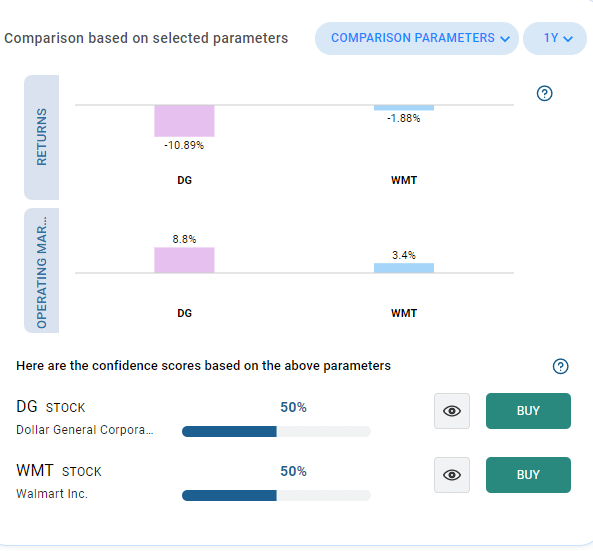Editor’s Note: Our experts here at INO.com cover a lot of investing topics and great stocks every week. To help you make sense of it all, every Wednesday we’re going to pick one of those stocks and use Magnifi Personal to compare it with its peers or competitors. Here we go…
Dollar stores - the no-frills discount retailers - were known for catering to the most cash-strapped consumers. These chains expanded rapidly to meet the needs of that demographic, with more than 19,000 Dollar General stores and more than 16,000 Dollar Tree and Family Dollar outlets now in North America.
But now, dollar stores’ demographic is changing, as inflation drives more and more middle-income consumers through their doors. One primary factor behind this trend is U.S. grocery prices, which were up 8.5% from March of 2022.
This emerging trend has led the industry’s two biggest chains - Dollar General (DG) and Dollar Tree (DLTR) - to both announce plans to remodel almost twice as many stores as they will open this year. Dollar General and Dollar Tree will increase the number of refitted stores by 11.4% and 25.6% from last year, respectively.
Both are investing heavily in freezers and coolers to meet growing demand for groceries from U.S. consumers who have shifted more spending from discretionary items to essential items like food.
Dollar General will increase capital spending by 22% this year, to $1.9 billion—about 142% above what it spent in the pre-pandemic fiscal year to January 2020. Dollar Tree is increasing its capital expenditure this year by about 60% to $2 billion, nearly double what it spent in the fiscal year to February 2020.
However, profit margins are lower for groceries than other items, so dollar stores have little incentive to push too far into the terrain of the likes of Walmart (WMT). UBS notes that dollar stores’ operating margins were more than double those of grocery chains last year. So, the number of food items available at dollar stores will be limited.
With that in mind, let's compare the largest of the dollar stores, Dollar General, against Walmart over this past volatile and inflationary year. The quick and easy way to do this to ask Magnifi Personal to run the comparison for us. It’s as simple as asking this investing AI to: “Compare DG to WMT.”
As you can see, it was a toss-up. While Walmart’s stock was less negative than Dollar General’s, its operating margin was much weaker than that for Dollar General.
This is an example of a response using Magnifi Personal. This image is not a recommendation or individual advice. Please see bottom disclaimer for additional information, including INO.com’s relationship with Magnifi.
This is just a starting point, of course. Magnifi Personal can easily compare several stocks or ETFs on more criteria, such as dividend payments, turnover, volume, and so on.
You can do it, too. Get access to Magnifi Personal completely free-of-charge - just click here.
This ability to have an investing AI pore over reams of data for you in seconds and spit out an easy-to-understand comparison of two or more stocks is an invaluable tool in deciding where to invest next.
We highly recommend you try it out. Click here to see how.
Magnifi Personal makes research like this as simple as typing a question. You can easily do this yourself, or ask Magnifi Personal to add other measures to the comparison, including dividend, valuation metrics such as P/E or P/B ratios, gross margin, and more.
Just click here to see how to set up your Magnifi Personal account.
INO.com, a division of TIFIN Group LLC, is affiliated with Magnifi via common ownership. INO.com will receive cash compensation for referrals of clients who open accounts with Magnifi.
Magnifi LLC does not charge advisory fees or transaction fees for non-managed accounts. Clients who elect to have Magnifi LLC manage all or a portion of their account will be charged an advisory fee. Magnifi LLC receives compensation from product sponsors related to recommendations. Other fees and charges may apply.
Diversification does not guarantee a profit or protect against a loss in a declining market. It is a method used to help manage investment risk.
Mutual Funds and Exchange Traded Funds (ETFs) are sold by prospectus. Please consider the investment objectives, risks, charges, and expenses carefully before investing. The prospectus, which contains this and other information about the investment company, can be obtained from the Fund Company or your financial professional. Be sure to read the prospectus carefully before deciding whether to invest.

